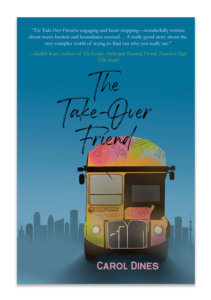One of the joys of writing is to deepen and expand my characters and plot through research. I consider research part of the writing process, sometimes the most fun part of the process. Over the years I have researched a wide range of topics from “how to catch a stalker” to “the impact of the palm oil industry on orangutans.” For my new novel, The Take-Over Friend, I researched the subject of “redheads” and “the social history of dogs.” Initially I wasn’t sure how I would weave in the research, but as I wrote the novel about Sonja and Frances and the evolution of their friendship, I was trying to reveal two creative, smart, sensitive girls who form a fast and intensely close friendship, a friendship that spins out of control when Sonja’s needs overwhelm Frances. The theme of the novel is how can we form deep relationships without losing ourselves. I wanted to use the research to create more authentic characters and a sense of their voices.
So where did the idea of researching the topic of redheads come from? Frances, the narrator of my story is a redhead and she comes from a family of redheads. (Full disclosure: I am a redhead too.) Frances is ashamed of her frizzy red hair because she can’t control it. As I researched the topic, I wasn’t sure how I would weave in the facts until I wrote one of the early scenes when Frances has just met her brilliant new friend Sonja. In this early conversation, Sonja has learned that Frances isn’t allowed to use Facebook and she asks Frances about her family’s religious background. Frances, the narrator, explains her mother is Unitarian and her father is Jewish:
“I’m Jewish on my mother’s side,” Sonja told me. “It’s carried through the mother’s line, so sorry, you’re not officially Jewish.” She grinned. “You’re probably Scottish. Sixteen percent of Scots have red hair. The red hair gene comes from the Middle East Steppe tribes around the Black Sea. It originated 4000 years ago. Also, there was a group of Native Americans who had red hair and cannibalistic tendencies, but another tribe, the Peyotes, burned them alive inside a cave. The whole tribe died. So your hair gene did not come through them.” She paused, sensing my skepticism. “I’m not making it up. I did my eighth-grade science project on genetic hair color. They only discovered the redhead gene in 2000. You have a better sense of smell, but you’re also prone to anxiety. It’s because your cells are wired to survive. Historically redheads were burned as witches and demons.”
“Really?”
She nodded. “You shouldn’t be in the sun, higher risk of melanoma. On the other hand, you attract males and bugs because you give off a unique smell. Your skin has more acid, not detectable to my nose.” She sniffed loudly, grinned, and tapped open Facebook on her phone.”
The second topic I researched was the social history of dogs. Frances, the narrator, is obsessed with dogs. She has two dogs in her family, Vinnie and Ravyn, who follow her around the house and sleep in her room at night. During the summer, she started a pet sitting business called Frances’s Furry Friends, and she takes care of her neighbors’ pets while they are on vacation. I wanted to weave in the social history of dogs to show the importance of dogs to Frances. Although I peppered the facts about dogs throughout the novel, revealing Frances’s knowledge of dogs, I used much of my research when Frances was given a semester-long assignment for her English class is to create a museum—she has to research the history and evolution of the topic, design the museum, and then write and deliver a research paper. Frances, of course, decides her museum will be The International Dog Museum. This is a scene near the end of the book when Frances delivers her paper to the class.
The following morning, I stood at the front of the room and took a deep breath. “Every time you see a dog that looks cute, ask yourself the cost of that cuteness. Dogs are known as humans’ best friends, and yet, we do not put their health and welfare above our own selfish needs. We want dogs that look cute, and that ‘cute’ factor means they are bred to fit the way we want them to look. This has led to puppy mills and the commodification of dogs, and today one in four purebreds is unhealthy, over-engineered to suit humans’ purposes.”
I cleared my throat. “For the last fifteen thousand years, dogs have played a role in humans’ lives. Dogs in the ancient world of Western Mexico were hairless and were believed to protect and guide humans. Roman dogs weighed 250 pounds and carried pots of burning pitch strapped on their backs. They were trained to go under enemy horses and panic them during battle. Thanks to collars found in tombs, we know the names of ancient Egyptian dogs: Good Herdsman, Reliable, One Who Is Fashioned as an Arrow, Fourth, Grabber, and Useless.”
Laughter broke out across the class, and I smiled. At least they were still awake.
“In the New World, dogs were seen as free labor, used to turn spits, pump bellows, churn butter, grind grain, and power sewing machines by running in wheels. Dogs were also used to heat people’s feet in Puritan churches, where services lasted for six or seven hours on Sundays. Dog-whippers were employed by the churches to control unruly dogs.”
I paused to glance at the clock, realizing I was running out of time. I skipped a page and continued, “Today research is exploding with new understandings about dogs and their gifts to humans.” I gave examples of dogs trained to sniff cancer, predict epileptic seizures, and detect low blood sugar in diabetes patients. “Recent studies have shown that dogs can be used for emotional support in helping veterans recover from PTSD—”
Ms. Riva’s buzzer went off. “I’m sorry, Frances, but your time is up.”
In this particular book, I used my research to deepen my characters’ personalities, passions, and to create more authentic voices. Research, too, keeps the writing interesting for me. It allows me to feel that I am always learning, always expanding my own knowledge in order to create authentic characters and link them to the world around them.
Here’s a look at Carol’s latest release THE TAKE-OVER FRIEND:
 A really good story about the very complex world of trying to find out who you really are.”-Judith Katz, author of The Escape Artist and Running Fiercely Toward A High Thin Sound.
A really good story about the very complex world of trying to find out who you really are.”-Judith Katz, author of The Escape Artist and Running Fiercely Toward A High Thin Sound.
On the second day of ninth grade, introverted Frances meets Sonja, a wildly funny newcomer from France, and the girls form a fast friendship. Frances adores Sonja’s worldliness, and Sonja adores Frances’s family, especially her older brother, Will. Frances and Sonja immediately declare themselves “The Poets” and rally their homeroom to enter the homecoming parade with a poetry-mobile built from Frances’s father’s old band bus. But respective family crises begin to escalate, and tensions come to a head when Sonja temporarily moves in with Frances’s family – forcing each friend to decide how close is too close. Alternatingly funny and poignant, The Take-Over Friend is a smart page-turner that focuses on the importance of finding your own voice in relationships.






